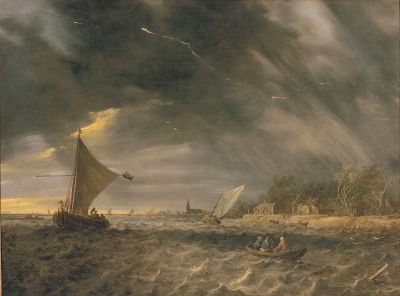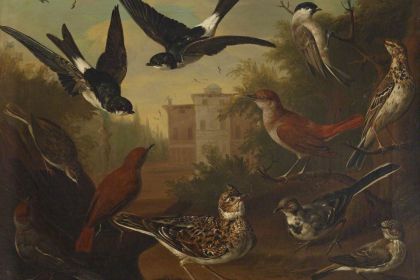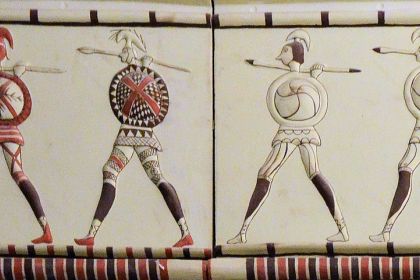Nature Sounds
8 orchestral pieces depicting thunderstorms

The Thunderstorm by Jan van Goyen
Of all the meteorological phenomena, thunderstorms are perhaps one of the most imposing forces of nature, so it is not at all surprising that many a rainstorm spewing thunder and lightning have been portrayed in classical music throughout the eras.
Starting from the Romantic period, composers began incorporating the themes proposed by contemporary writers and visual artists into their music. This often led to the musical interpretations of natural landscapes in combination with weather phenomena, all of which were represented by specialized instruments introduced into symphonic orchestras to imitate thunderclaps, the howling of the wind, and the violent lashing of a rain shower.
Nature sounds, birdsongs, сrickets choirs, and buzzing insects were not only intensively imitated by classical composers but they also found their way into popular music where the nature soundscapes became widely used once recording technologies have developed sufficiently. Nowadays, nature sounds form a separate industry, offering a wide range of soundscapes from different parts of the world for those urbanized listeners who seek tranquility and relaxation in nature's harmony.
Listen to Spring thunderstorm, wind, rain, birds, crickets recorded at sunset in the woods:
Even during the Baroque era, when percussion instruments were not an integral part of orchestras, storms were imitated by Georg Philipp Telemann and Marin Marais, while Antonio Vivaldi created most stunning works portraying spring and summer storms in his famous cycle The Four Seasons and also dedicated one of his flute concertos to such a phenomenon as the storm at sea.
Listen to Vivaldi's Concerto for Flute and Strings in F major "La tempesta di mare" performed Jean-Pierre Rampal with English Chamber Orchestra:
Perhaps the most realistic description of thunder and lightning is heard in Beethoven's Pastoral Symphony, where timpani patterns imitate the spread of thunderclaps, while abrupt violin motives symbolize flashes of lightning. Here, the dynamic passages oppose the calm parts of the piece, creating a distinct impression of pauses in the thunderstorm and the subsequent abatement of the tempest as its epicenter moves away.
Listen to IV. Allegro from Symphony No. 6 performed by Georg Solti with London Symphony Orchestra:
A sudden thunderstorm in a forest landscape is portrayed by Jean Sibelius in his tonal poem Tapiola which depicts Tapia, an animating forest spirit often mentioned in Karelian and Finnish folklore. A mostly calm narration of the symphonic poem turns into a short storm that swoops in and rages well into the twelfth minute of the performance. The final section of the work contains very dynamic parts associated with the sound of a strong wind able to bend even the strongest of trees to its will.
Listen to Sibelius' Tapiola performed by Herbert von Karajan with Berliner Philharmoniker:
From the very first chords of Thunder and Tempest, Descent from An Alpine Symphony written by Richard Strauss, it becomes clear that a thunderstorm in the Alps is a really dangerous element. The flashes of lightning are imitated here by brass, whereas thunder is depicted by timpanis, and violins are once again associated with fierce gusts of wind. Curiously, the 1981 recording of An Alpine Symphony performed by Herbert von Karajan with the Berlin Philharmonic made history as the first work ever to be burned on the compact disc format.
Listen to Richard Strauss' Thunder and Tempest, Descent from An Alpine Symphony performed by Herbert von Karajan with Berliner Philharmoniker:
Royal Hunt and Storm from Hector Berlioz's opera The Trojans portray a sudden summer rainstorm during which lovers take shelter in a cave. The action culminates in lightning striking a tree that flares up and is toppled to the ground to the great delight of satyrs and fauns who pick up the flaming branches and dance with them.
Listen to Hector Berlioz's Royal Hunt and Storm performed by Herbert von Karajan with Philharmonia Orchestra:
Mesmerizing seascapes become engulfed by thunderstorms in the finals of two outstanding works by 20th-century English composers Benjamin Britten and Frank Bridge. In honor of Britten's centenary, his Four Sea Interludes cycle containing Dawn, Sunday Morning, Moonlight, and the Storm was recently staged right on the composer's home beach in Aldeburgh.
Listen to Storm from the Four Sea Interludes performed by André Previn with London Symphony Orchestra:
It is reported that the orchestral suite The Sea, written by Frank Bridge in the 1910s, was the first piece of contemporary classical music heard by the ten-year-old Britten who, in his own words, was "knocked sideways". Subsequently, Britten became Bridge's student, and it's not surprising that the Four Sea Interludes shows a similar mood to that of The Sea, both works sharing marine themes even in the titles of their respective movements.
Listen to Franck Bridge's The Sea, Storm performed by Charles Groves with Royal Liverpool Philharmonic:
Dramatic orchestral imitation of the thunderstorm can also be found in the Grand Canyon Suite by American composer Ferde Grofé. The piece consists of five movements, each one evoking a particular scene that could be encountered in the Grand Canyon: Sunrise, Painted Desert, On the Trail, Sunset, and, finally, Cloudburst. A powerful thunderstorm hailing down after sunset is shown through rhythmic timpani strikes that mimic thunder, and the crashes of cymbals embody the flashes of lightning. The whistle of the wind, as in previous examples, is depicted by somewhat chaotic violin passages.
Listen to Ferde Grofé's Cloudburst from Grand Canyon Suite performed by Leonard Bernstein with New York Philharmonic Orchestra:
As the examples show, most of the symphonic imitations of thunderstorms have been written during the last two centuries. In early music, a truthful description of the formidable forces of nature was hardly possible due to a small variety of orchestral instruments and insufficient development of musical syntax, while the main compositional inspirations of the Classical era were centered around contemporaneous human achievements such as architecture and visual arts rather than around nature.
Listen to Summer thunderstorm, wind, and rain recorded at sunset in the woods:
Download HQ soundscapes for free, recorded in a mixed forest, including bird songs, cricket choruses, and night or afternoon thunderstorms.



